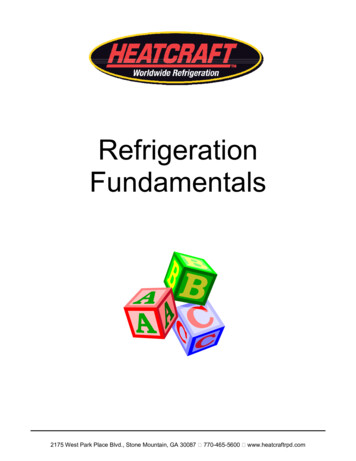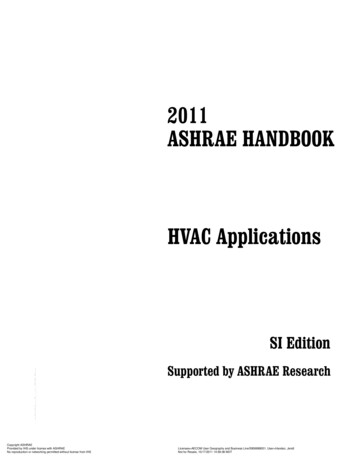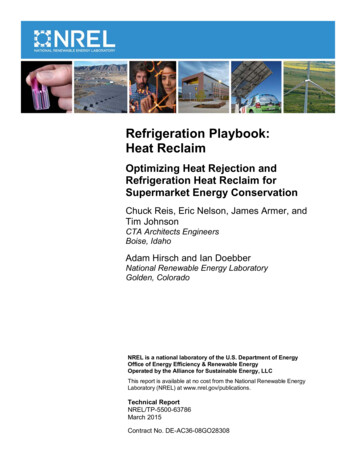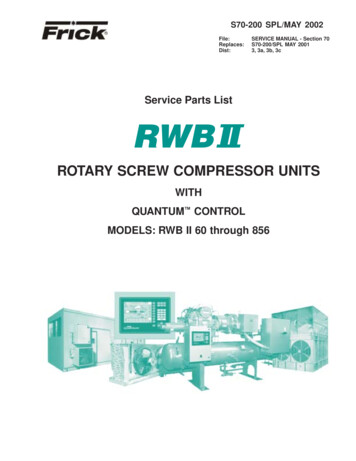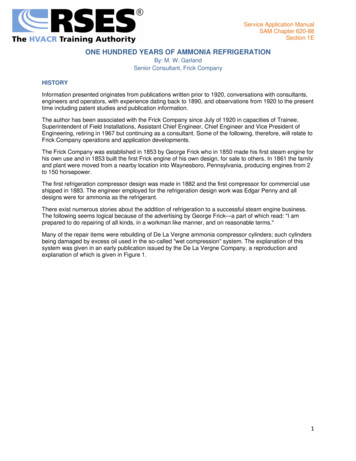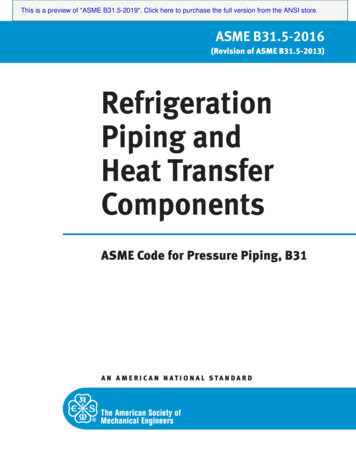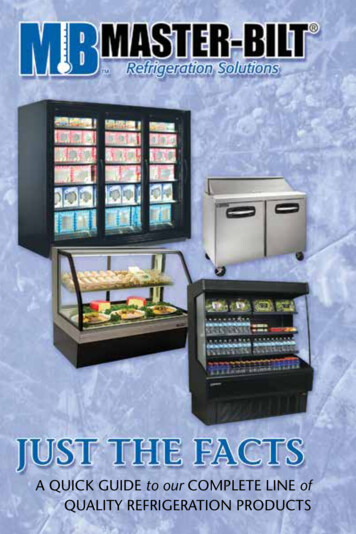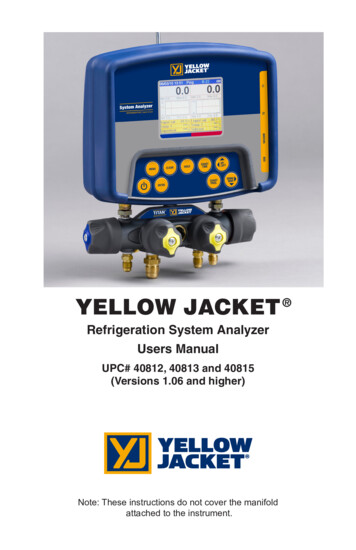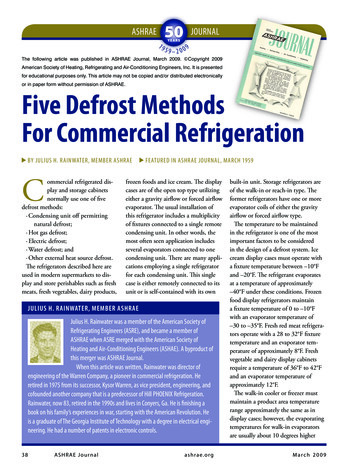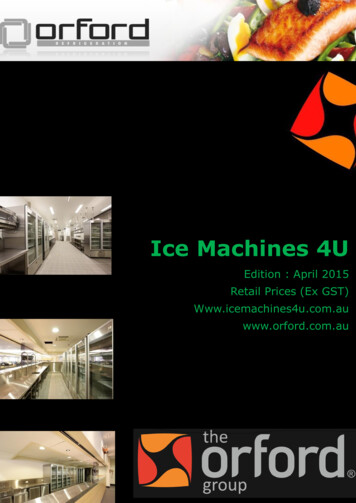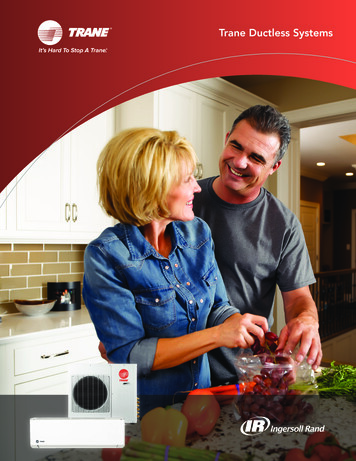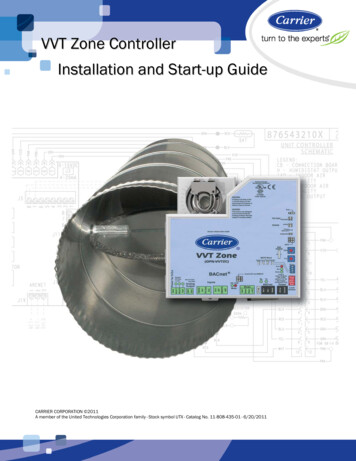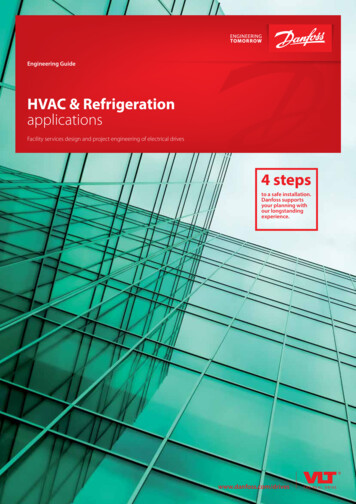
Transcription
Engineering GuideHVAC & RefrigerationapplicationsFacility services design and project engineering of electrical drives4 stepsto a safe installation.Danfoss supportsyour planning withour longstandingexperience.www.danfoss.com/drives
The removable design checklist at the back of this guide leadsyou to optimal design results in four steps.2
ContentsDesign aids.6Part 1: Basics.8Reducing costs and increasing convenience.8Speed control saves energy.9Boosting cost effectiveness.10Achieving potential savings in practice.11Part 2: Four steps to an optimal system. 12Step 1: Practical aspects of AC mains systems. 12Recognising the actual mains configurationPractical aspects of electromagnetic compatibility (EMC). 13Electromagnetic effects work in both directionsThe responsibility rests with the operatorTwo possible means of reductionDistinguishing between conducted and radiated interference.14Coupling mechanisms between electrical circuitsConductive couplingCapacative couplingRadiation couplingPractical aspects of mains power quality. 15Low-frequency mains interferenceSupply networks at riskQuality assured by statutory provisionsHow mains interference occursPractical aspects of low- frequency mains interference . 16Effects of mains interferenceUndervoltage warningsHigher lossesAre interference- free frequency converters available ?Analysing mains interferencePractical aspects of mains interference reduction. 17Options for reducing mains interferenceChokes at the input or in the DC linkRectifier with 12, 18 or 24 pulses per cyclePassive filtersAdvantages of passive filtersDrawbacks of passive filtersActive filters.18Advantages of active filtersDrawbacks of active filtersCurrent and Distortion Spectrum at Full loadSlim DC link.19Active front endAdvantages of AFE . 20Drawbacks of AFEPractical aspects of high-frequency interference (RFI). 21Radio frequency interferenceStandards and directives define limitsPractical aspects of 1st and 2nd environment . 22The operating site is the decisive factorEnvironment 1 (Class B): residential environmentEnvironment 2 (Class A): industrial environmentSpecial environmentsNo compromisesPractical aspects of mains protection measures. 23Power factor correctionMains transientsPractical aspects of operation with a transformer or standby generator. 24Maximum transformer utilisationTransformer loadPower qualityOperation with a standby generator3
ContentsStep 2: Practical aspects of ambient and environmental conditions.25The right installation locationCabinet mount versus wall mountPractical aspects of enclosure ratings.26IP rating scheme according to IEC 60529NEMA enclosure types according to NEMA 250-2003Practical aspects of cooling design.27Compliance with ambient temperature specificationsCoolingRelative humidityPractical aspects of special requirements.28Aggressive atmosphere or gasesDust exposure .29Reduced coolingCooling fansFilter matsPractical aspects of potentially explosive atmospheres.30Potentially explosive atmospheresStep 3: Practical aspects of motors and cabling.31Minimum efficiency classes for motorsMandatory minimum efficienciesIE and Eff classes: major differences in detailsAffected three-phase motorsPractical aspects of IE classification of motors. .32Schedule for MEPS implementationCompliance with EN 50347 mounting dimension specificationsCost-effectivenessPractical aspects of EC and PM motors . .33What are EC Motors ?Efficiency of EC MotorsPM-motors – an alternative to EC ?The Danfoss EC concept . .34Does the best motor efficiency yield the best system efficiency ?Practical aspects of motor suitability for frequency converter operation.35Selection criteriaInsulation stressBearing stressThermal stressPractical aspects of output filters.36Sine-wave and du/dt filtersFunctions and tasks of sine-wave filtersWhen are sine-wave filters used?RetrofittingPractical aspects of motor cables.37Rated voltageCable dimensioningMotor cable lengthEnergy savingsCables with suitable shieldingPractical aspects of earthing.38The importance of earthingElectrically conductive materialsStar-configured earthing systemContact pointsConductor surface area4
Practical aspects of shielding.39The importance of shieldingShielded cables and wiringShield connectionShield gapsGround connection. 40Motor supply cableSignal cableTypes of shieldsStep 4: Practical aspects of frequency converter selection.41Basic designConstant or variable torquePractical aspects of load curves for HVAC/R applications .42Characteristic curves and applicationsPractical aspects of multi-motor operation (special case).43DesignCable routingPractical aspects of EMC measures.44Putting theory into practiceRadio frequency interferencePractical recommendationsTwo approaches to RFI filtersMains interference . 45The DC link affects mains interferenceReduction measuresMains chokesRectifiers with 12, 18 or 24 pulses per cycle. 46Passive filtersActive filters, active front ends and low harmonic drivesPractical aspects of residual current devices.47AC/DC residual current protective devicesLeakage current levelPractical aspects of earthing and motor protection.48Earthing measures in practiceMotor protection and motor PTC thermistorPractical aspects of operator control and data display.49Simple operating conceptOperation under local control. 50Clear displayUniform conceptIntegrated in the cabinet doorPractical aspects of control and parameter configuration with a PC.51Extended optionsPractical aspects of data exchange.52Bus systemsBetter alarm managementBetter facility managementLower installation costsSimplified commissioningPractical aspects of additional selection factors.53Process controllerMaintenanceStorageVLT HVAC Drive.54Directives related to frequency n checklist.625
Design aids for high-leveland detailed designEngineering Guide for HVAC/RapplicationsThe Danfoss Engineering Guide forHVAC and Refrigeration applicationsis aimed at engineering firms, publicauthorities, associations, plant engineers and electrical engineersactively involved in HVAC/R technology. It is conceived as a comprehensive aid for facility services designers(ICA and electrical) and projectengineers whose scope of responsibility includes the project engineering of variable-speed systems usingfrequency converters.For this purpose, our specialists havecoordinated the contents of thisdesign manual with facility servicesdesigners in t
HVAC & Refrigeration applications Engineering Guide. 2 The removable design checklist at the back of this guide leads you to optimal design results in four steps. 3 Design aids. 6 Part 1: Basics. 8 Reducing costs and increasing convenience. 8 Speed control saves energy. 9 Boosting cost effectiveness.10 Achieving potential savings in practice.11 Part 2: Four steps to an .
